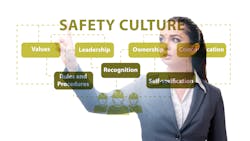Creating a safety culture and infection control awareness in the dental office
As the world continues the process of picking itself back up, dusting itself off, and trying to figure out how to recover from the COVID-19 pandemic, dental offices are reopening and preparing to return to regular or semi-regular patient care. With enhanced knowledge of how infections spread and the current climate of fear, creating a more visibly safe health-care environment is more critical than ever.1
Creating a safety culture to entice patients back and reassure them that they are protected from infection while in your care will be essential. Patients want and need to feel secure as well as have their COVID-19 fears eased. This is especially pertinent when dealing with patients who are susceptible to periodontal or peri-implant diseases.2
So, how do you reassure your patients and get them back to your practice? Through excellent communication, transparency, accountability, and trust, of course! These are the building blocks that will support your practice in this time of doubt and global fear.
Legacy standards
In the dental profession, we have all witnessed subpar standards and lack of infection control. While clinicians may have “gotten away” with lax procedures previously, that is no longer the case. Now, with the added complications of COVID-19 and the general public being more aware of the high levels of hygiene their safety requires, there is no room for laziness or haphazard protocols.
All dental offices should be examining their hygiene and infection control standard operating procedures (SOPs) in detail to close any loopholes or unsatisfactory practices as well as writing plans to combat any insufficient practices. Your patients’ health and safety should be of the highest priority.
Relying on old-school methods, outdated technology, and undertrained staff just won’t cut it anymore. In fact, in a recent survey, 47% of hygienists said they wished for improved infection control in their office, highlighting that it was far from perfect pre–COVID-19.3
Updating your SOPs, protocols, and methods of infection control are paramount to creating a culture of safety in your practice. Make sure proper structures are in place, step-by-step procedures are in writing, and staff members are receiving the necessary training to avoid the recurrence of legacy errors or repetition of mistakes. Approach infection prevention as if you were learning for the first time and implement the highest standards. Complacency is dangerous for everyone.
Here are some of the key aspects to examine and adjust to protect your patients, team, and business:
- Personal hygiene: In general, most dental health practitioners already have high standards when it comes to hygiene levels. However, as part of your SOPs, add in guidelines about personal cleanliness. In handwashing stations and restrooms, post detailed diagrams and information on the importance of proper handwashing. Having written protocols to define nail length, nail polish, wearing of jewelry, and guidelines for facial hair will be important in your SOPs.
- Clean environment: Now is a good time for a deep clean of the entire clinic. While everything is being cleaned, review your processes and examine the methods and products you use in your office. Create clear, simple-to-follow SOPs detailing how every piece of equipment and surface is to be sterilized and disinfected. Check that the products you use are fit for the facility’s equipment.
- Infection control coordinator (ICC): It is advisable to designate a team member to be the ICC who is responsible for the overall management of infection control in your office. While every member of the team is responsible for maintaining hygiene standards and patient safety, having one person who monitors procedures, reminds staff of their roles, and provides leadership is absolutely necessary.4 The staff member who is in charge of infection prevention should also help organize ongoing training for all team members to ensure that everyone is up to speed on current health and safety practices. The infection control climate is ever-changing such that the role of the ICC is even more critical.
- Personal responsibility: Making everyone accountable for his or her actions and emphasizing personal responsibility are crucial in our practices. You, your colleagues, and patients must all ensure that they do not come into the office if they are ill. Take time off work or request the rescheduling of appointments rather than putting everyone at risk, even if it is just a common cold.5 When taking appointments, make asking patients about their health a standard part of the process. Also, make it clear to patients that if they are unwell—particularly with a fever or a COVID-19 diagnosis—they should postpone their visit to your office.
Standards by state
Not all states have standard infection control regulations for continuing education (CE), but that does not mean the dental practice can't implement best practices in the clinic. Look at the most stringent controls in the more highly regulated states and try to emulate those to the best of your ability. Aim for the highest levels possible, and this will help patients feel cared for and safe.
CE Zoom, an all-inclusive continuing education management system, reviewed state licensing requirements and found that 21 out of 50 states require infection prevention courses for license renewal. Two states did not require infection prevention courses for both the dentist and dental hygienist. CE Zoom found that one state requires infection control courses once every four years, three states require them once every three years. The remaining 17 states require infection prevention courses once every two years. That leaves 29 states that do not require completion of infection control courses to renew a dental professional’s license. To put that into perspective, there is no guarantee in those 29 states not requiring infection control courses for license renewal that a dental professional has updated knowledge of infection control practices.
Patient safety is the foundation of patient care, but who is making sure that clinicians have this top of mind? In 2003, the Centers for Disease Control and Prevention (CDC) released guidelines for the dental practice and updated them in 2016.6 How do we ensure that dental practices and clinicians are up-to-date on the regulations and recommendations from federal and state entities as they treat patients? It is time to mandate infection prevention and/or make Occupational Safety and Health Administration (OSHA) courses mandatory in all states. The pandemic has taught many professionals about the need for up-to-date protocols in the dental practice.
Communication is key
At all levels in your clinic, communicating your hygiene goals and standards will help rebuild trust. The use of signage to remind people to wash their hands and clean equipment properly will reinforce how important infection control is in your office. Display hygiene certificates and best-practice guidelines throughout the office to help reassure and remind both staff and patients.
If you discover someone who is not following protocols, address the situation appropriately without shaming or degrading the individual involved. Make safe practices a team effort and have clearly stipulated procedures and guidelines that don't allow for misinterpretation. You can draw up all the best SOPs and best-practice documents in the world and yet they will be ineffectual without a culture of trust and clear communication with your team (and in some cases, your patients).7
If something does go wrong that results in an adverse event (AE), there must be a complete record of that event.8 If you don’t have one already, develop a Patient Safety Toolkit and implement the recording of data in an appropriate storage place.9 Remember that an incident such as health-care-acquired infection is not only detrimental to your patient; it can have widespread repercussions in your clinic too. Negative press, the possibility of being sued, and facing an increase in insurance rates could lead to your practice going out of business and loss of license.
While creating a safety culture should not be a costly endeavor, your practice may have to invest in enhanced-quality personal protective equipment (PPE), cleaning products, and updated equipment. These investments make economic sense as they protect the clinic from expensive legal action, loss of business, and/or being shut down by the authorities.9
As we welcome our teams and patients back into our practices, it is more vital than ever to work on our communication skills while providing transparency, building trust, and accepting full accountability for our actions and education in infection prevention. This is the only way that we can rebuild our profession and come back stronger and safer. Infection control is an integral part of protecting our teams and patients.
Author’s note: You can hear more of my thoughts on infection control and aerosols in my interview with David Rice, DDS, from IgniteDDS on YouTube.
Also by the author:
- COVID-19 and the problem with aerosols
- In the days of dental implants, why should we be keeping teeth?
Editor’s note: This article originally appeared in Perio-Implant Advisory, a newsletter for dentists and hygienists that focuses on periodontal- and implant-related issues. Perio-Implant Advisory is part of the Dental Economics and DentistryIQ network. To read more articles, visit perioimplantadvisory.com and subscribe at this link.
References
- Choi EM, Mun SJ, Chung WG, Noh HJ. Relationships between dental hygienists’ work environment and patient safety culture. BMC Health Serv Res. 2019;19(1):299. doi:10.1186/s12913-019-4136-8
- Prathapachandran J, Suresh N. Management of peri-implantitis. Dent Res J (Isfahan). 2012;9(5):516-521.
- Strange M. And the survey says … we gotta step up our infection control game! RDH magazine. April 23, 2020. Accessed June 22, 2020. https://www.rdhmag.com/infection-control/article/14174660/and-the-survey-says-we-gotta-step-up-our-infection-control-game
- Strange M. Promoting infection control practices in your dental office. Dental Economics. April 1, 2020. Accessed June 22, 2020. https://www.dentaleconomics.com/science-tech/sterilization-and-infection-control/article/14173407/promoting-infection-control-practices-in-your-dental-office
- When your coworkers come to work sick. O2 Nose Filters. October 2, 2019. Accessed June 22, 2020. https://www.o2nosefilters.com/when-your-coworkers-come-to-work-sick/
- Centers for Disease Control and Prevention. Summary of Infection Prevention Practices in Dental Settings: Basic Expectations for Safe Care. Centers for Disease Control and Prevention, US Dept of Health and Human Services. October 2016. https://www.cdc.gov/oralhealth/infectioncontrol/pdf/safe-care2.pdf
- Ciardello D. 4 guidelines for writing effective standard operating procedures. DentistryIQ. July 9, 2019. June 22, 2020. https://www.dentistryiq.com/front-office/scheduling/article/14035940/4-guidelines-for-writing-effective-standard-operating-procedures
- Kalenderian E, Obadan-Udoh E, Maramaldi P, et al. Classifying adverse events in the dental office [published online ahead of print, June 30, 2017]. Accessed June 22, 2020. J Patient Saf. 2017; 10.1097/PTS.0000000000000407. doi:10.1097/PTS.0000000000000407
- Stewart D, Kalenderian E. Ensuring patient safety in dentistry. American Dental Association. National Institute of Dental and Craniofacial Research. Accessed June 22, 2020. https://www.ada.org/~/media/ADA/Education%20and%20Careers/Files/Ensuring_patient_safety_in_dentistry_Stewart_and_Kalenderian_for_posting_v2.pdf
Michelle Strange, MSDH, RDH, has been a dental clinician since 2000 and is currently a practicing hygienist, speaker, writer, content developer, consultant, and podcast cohost for A Tale of Two Hygienists. With a master's in dental hygiene education and a belief in lifelong learning, she hopes to continue to learn and grow within the dental profession and one day see the gap bridged between medicine and dentistry.









